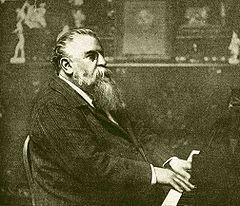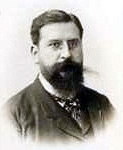
Raoul Pugno
Encyclopedia

Raoul Pugno was born in Paris
Paris
Paris is the capital and largest city in France, situated on the river Seine, in northern France, at the heart of the Île-de-France region...
. He made his debut at the age of six, and with the help of Prince Poniatowski he was then able to study at the École Niedermeyer. He then went to the Paris Conservatoire
Conservatoire de Paris
The Conservatoire de Paris is a college of music and dance founded in 1795, now situated in the avenue Jean Jaurès in the 19th arrondissement of Paris, France...
at age 14, where he shone. He won First Prize in Piano in 1866 (his teacher being Georges Mathias
Georges Mathias
Georges Amédée Saint-Clair Mathias was a French composer, pianist and teacher.Mathias was born in Paris. He studied at the Paris Conservatory with François Bazin, Auguste Barbereau, Augustin Savard and Fromental Halévy, composition with Friedrich Kalkbrenner and piano with Frédéric Chopin. He was...
, a pupil of Frédéric Chopin
Frédéric Chopin
Frédéric François Chopin was a Polish composer and virtuoso pianist. He is considered one of the great masters of Romantic music and has been called "the poet of the piano"....
), First Prize in Harmony and First Medal for solfege in 1867 (his composition teacher being Ambroise Thomas
Ambroise Thomas
Charles Louis Ambroise Thomas was a French composer, best known for his operas Mignon and Hamlet and as Director of the Conservatoire de Paris from 1871 till his death.-Biography:"There is good music, there is bad music, and then there is Ambroise Thomas."- Emmanuel Chabrier-Early life...
), and First Prize in Organ in 1869 (his teacher was Francois Benoist
François Benoist
François Benoist was a French organist, composer, and pedagogue.Benoist was born in Nantes. He studied music at the Conservatoire de Paris and won the Prix de Rome in 1815 for his cantata Œnone. In 1819, he became organist and professor of organ at the Conservatoire; he held the latter post for...
). He was appointed Director of Music at the Opéra by the Paris Commune of March-May 1871. At the grand re-opening of the Opéra, two of his works were performed.
He was organist at the Church of Saint-Eugène 1872-92, chorus master at the Theatre Ventador in 1874, and Professor of Harmony at the Conservatoire 1892-96 and Professor of Piano 1896-1901.

Léo-Pol Morin
Léo-Pol Morin was a Canadian pianist, music critic, composer, and music educator. He composed under the name James Callihou, with his most well known works being Suite canadienne and Three Eskimos for piano. He also composed works based on Canadian and Inuit folklore/folk music and harmonized a...
. He then decided to resume his career as a concert pianist, commencing with the Piano Concerto in A minor
Piano Concerto (Grieg)
The Piano Concerto in A minor, Op. 16, composed by Edvard Grieg in 1868, was the only concerto Grieg completed. It is one of his most popular works and among the most popular of all piano concerti.-Structure :The concerto is in three movements:...
by Edvard Grieg
Edvard Grieg
Edvard Hagerup Grieg was a Norwegian composer and pianist. He is best known for his Piano Concerto in A minor, for his incidental music to Henrik Ibsen's play Peer Gynt , and for his collection of piano miniatures Lyric Pieces.-Biography:Edvard Hagerup Grieg was born in...
. At a performance of Richard Wagner
Richard Wagner
Wilhelm Richard Wagner was a German composer, conductor, theatre director, philosopher, music theorist, poet, essayist and writer primarily known for his operas...
's Das Rheingold
Das Rheingold
is the first of the four operas that constitute Richard Wagner's Der Ring des Nibelungen . It was originally written as an introduction to the tripartite Ring, but the cycle is now generally regarded as consisting of four individual operas.Das Rheingold received its premiere at the National Theatre...
in 1893, Pugno and Claude Debussy
Claude Debussy
Claude-Achille Debussy was a French composer. Along with Maurice Ravel, he was one of the most prominent figures working within the field of impressionist music, though he himself intensely disliked the term when applied to his compositions...
provided an accompaniment on two pianos. He had a brilliant career, travelling throughout Europe and to the United States, where American composer Marion Bauer
Marion Bauer
Marion Eugénie Bauer was an American composer, teacher, writer, and music critic. A contemporary of Aaron Copland, Bauer played an active role in shaping American musical identity in the early half of the twentieth century....
acted as guide and translator for Pugno and his family.
His specialty was the solo piano works and piano concertos of Wolfgang Amadeus Mozart
Wolfgang Amadeus Mozart
Wolfgang Amadeus Mozart , baptismal name Johannes Chrysostomus Wolfgangus Theophilus Mozart , was a prolific and influential composer of the Classical era. He composed over 600 works, many acknowledged as pinnacles of symphonic, concertante, chamber, piano, operatic, and choral music...
. Pugno was also a fine interpreter of the piano works of Chopin and César Franck
César Franck
César-Auguste-Jean-Guillaume-Hubert Franck was a composer, pianist, organist, and music teacher who worked in Paris during his adult life....
. He was also renowned for his appearances with the violinist Eugène Ysaÿe
Eugène Ysaÿe
Eugène Ysaÿe was a Belgian violinist, composer and conductor born in Liège. He was regarded as "The King of the Violin", or, as Nathan Milstein put it, the "tzar"...
, with whom he worked from 1896, giving performances of works by Gabriel Fauré
Gabriel Fauré
Gabriel Urbain Fauré was a French composer, organist, pianist and teacher. He was one of the foremost French composers of his generation, and his musical style influenced many 20th century composers...
, Camille Saint-Saëns
Camille Saint-Saëns
Charles-Camille Saint-Saëns was a French Late-Romantic composer, organist, conductor, and pianist. He is known especially for The Carnival of the Animals, Danse macabre, Samson and Delilah, Piano Concerto No. 2, Cello Concerto No. 1, Havanaise, Introduction and Rondo Capriccioso, and his Symphony...
, and Ernest Chausson
Ernest Chausson
Amédée-Ernest Chausson was a French romantic composer who died just as his career was beginning to flourish.-Life:Ernest Chausson was born in Paris into a prosperous bourgeois family...
. The duo also gave the premiere performances of violin sonatas by Albéric Magnard
Albéric Magnard
Lucien Denis Gabriel Albéric Magnard was a French composer, sometimes referred to as the "French Bruckner", though there are significant differences between the two composers...
and Louis Vierne
Louis Vierne
Louis Victor Jules Vierne was a French organist and composer.-Life:Louis Vierne was born in Poitiers, Vienne, nearly blind due to congenital cataracts, but at an early age was discovered to have an unusual gift for music. Louis Victor Jules Vierne (8 October 1870 – 2 June 1937) was a French...
. He also appeared with the violinist Leopold Auer
Leopold Auer
Leopold Auer was a Hungarian violinist, teacher, conductor and composer.-Early life and career:...
.
He spent his summers at his home in Gargenville where he taught and entertained, often playing concertos and works for two pianos with Saint-Saëns and the young Nadia Boulanger
Nadia Boulanger
Nadia Boulanger was a French composer, conductor and teacher who taught many composers and performers of the 20th century.From a musical family, she achieved early honours as a student at the Paris Conservatoire, but believing that her talent as a composer was inferior to that of her younger...
.
Pugno was the first internationally renowned pianist to make recordings. In 1903 he recorded pieces by George Frideric Handel
George Frideric Handel
George Frideric Handel was a German-British Baroque composer, famous for his operas, oratorios, anthems and organ concertos. Handel was born in 1685, in a family indifferent to music...
, Domenico Scarlatti
Domenico Scarlatti
Giuseppe Domenico Scarlatti was an Italian composer who spent much of his life in the service of the Portuguese and Spanish royal families. He is classified as a Baroque composer chronologically, although his music was influential in the development of the Classical style...
and Chopin and one of his own compositions, an Impromptu Valse. In a Chopin waltz, Pugno displays his famous jeu de perle technique. His other Chopin recordings include the Impromptu in A flat, Op. 29, Berceuse, Op. 57, Waltz in A flat, Op. 34 No. 1, and the Marche funèbre from the Sonata in B flat minor. Pugno's most important recording however, is that of Chopin's Nocturne in F sharp, Op. 15, No. 2, in which he plays the piece noticeably slower than the norm, a practice bequeathed to him by his teacher Georges Mathias, himself a student of Chopin. It can be heard here, although the sound is distorted because the record was cut on a defective turntable with fluctuating speed. His most extended recording is that of Franz Liszt
Franz Liszt
Franz Liszt ; ), was a 19th-century Hungarian composer, pianist, conductor, and teacher.Liszt became renowned in Europe during the nineteenth century for his virtuosic skill as a pianist. He was said by his contemporaries to have been the most technically advanced pianist of his age...
's Hungarian Rhapsody No. 11. It is impetuous and exciting, and has Pugno pushing himself to the extremes of his abilities without any loss of control.
Raoul Pugno died in 1914 in Moscow
Moscow
Moscow is the capital, the most populous city, and the most populous federal subject of Russia. The city is a major political, economic, cultural, scientific, religious, financial, educational, and transportation centre of Russia and the continent...
, while on a concert tour of Russia. His compositions are forgotten now, but his legacy lives on through his students.
Selected works
- Oratorio La Resurrection de Lazare (1879)
- Feerie La Fee Cocotte
- Ballet Les Papillons (London, 1881)
- Opera-comique Ninetta (1882)
- Opera-bouffe Le Sosie (1887)
- Opera-comique Le Valet de coeur (1888)
- Operas Le Retour d’Ulysse (1889), La Vocation de Marius (1890), La Petite Poucette (1891), Melusine
- Pantomime La Danseuse de corde (1892)
- Mimodrame Pour le drapeau (1895)
- Ballet Le Chevalier aux fleurs (1897, with André MessagerAndré MessagerAndré Charles Prosper Messager , was a French composer, organist, pianist, conductor and administrator. His stage compositions included ballets and 30 opéra comiques and operettas, among which Véronique, had lasting success, with Les p'tites Michu and Monsieur Beaucaire also enjoying international...
) - Incidental music for Gabriele d'AnnunzioGabriele D'AnnunzioGabriele D'Annunzio or d'Annunzio was an Italian poet, journalist, novelist, and dramatist...
’s Citta morte, with Nadia BoulangerNadia BoulangerNadia Boulanger was a French composer, conductor and teacher who taught many composers and performers of the 20th century.From a musical family, she achieved early honours as a student at the Paris Conservatoire, but believing that her talent as a composer was inferior to that of her younger... - Songs
- Piano sonata
- Piano pieces
Recordings
- Legendary Piano Recordings: The Complete Grieg, Saint-Saëns, Pugno, and Diémer (Marston Records)
Sources
- Grove V (1961)
- Naxos biography

